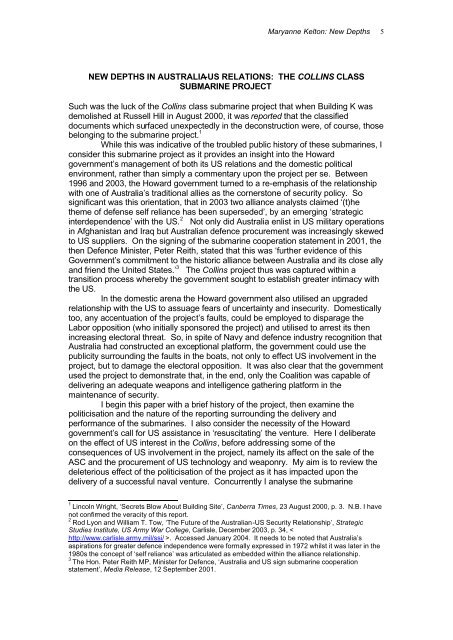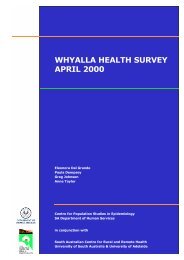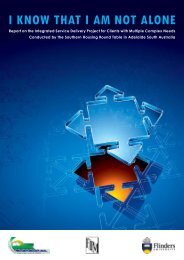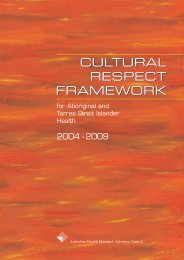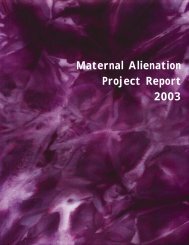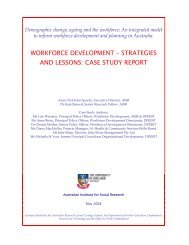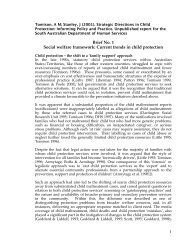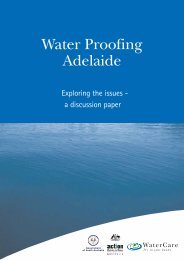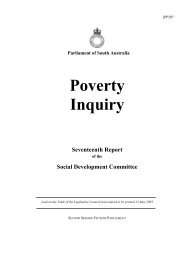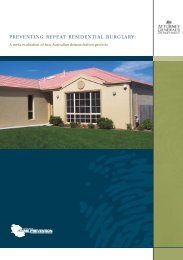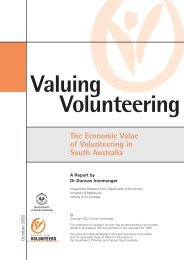New Depths in Australia-US Relations: The Collins Class ...
New Depths in Australia-US Relations: The Collins Class ...
New Depths in Australia-US Relations: The Collins Class ...
Create successful ePaper yourself
Turn your PDF publications into a flip-book with our unique Google optimized e-Paper software.
Maryanne Kelton: <strong>New</strong> <strong>Depths</strong> 5NEW DEPTHS IN A<strong>US</strong>TRALIA-<strong>US</strong> RELATIONS: THE COLLINS CLASSSUBMARINE PROJECTSuch was the luck of the Coll<strong>in</strong>s class submar<strong>in</strong>e project that when Build<strong>in</strong>g K wasdemolished at Russell Hill <strong>in</strong> August 2000, it was reported that the classifieddocuments which surfaced unexpectedly <strong>in</strong> the deconstruction were, of course, thosebelong<strong>in</strong>g to the submar<strong>in</strong>e project. 1While this was <strong>in</strong>dicative of the troubled public history of these submar<strong>in</strong>es, Iconsider this submar<strong>in</strong>e project as it provides an <strong>in</strong>sight <strong>in</strong>to the Howardgovernment’s management of both its <strong>US</strong> relations and the domestic politicalenvironment, rather than simply a commentary upon the project per se. Between1996 and 2003, the Howard government turned to a re-emphasis of the relationshipwith one of <strong>Australia</strong>’s traditional allies as the cornerstone of security policy. Sosignificant was this orientation, that <strong>in</strong> 2003 two alliance analysts claimed ‘(t)hetheme of defense self reliance has been superseded’, by an emerg<strong>in</strong>g ‘strategic<strong>in</strong>terdependence’ with the <strong>US</strong>. 2 Not only did <strong>Australia</strong> enlist <strong>in</strong> <strong>US</strong> military operations<strong>in</strong> Afghanistan and Iraq but <strong>Australia</strong>n defence procurement was <strong>in</strong>creas<strong>in</strong>gly skewedto <strong>US</strong> suppliers. On the sign<strong>in</strong>g of the submar<strong>in</strong>e cooperation statement <strong>in</strong> 2001, thethen Defence M<strong>in</strong>ister, Peter Reith, stated that this was ‘further evidence of thisGovernment’s commitment to the historic alliance between <strong>Australia</strong> and its close allyand friend the United States.’ 3 <strong>The</strong> Coll<strong>in</strong>s project thus was captured with<strong>in</strong> atransition process whereby the government sought to establish greater <strong>in</strong>timacy withthe <strong>US</strong>.In the domestic arena the Howard government also utilised an upgradedrelationship with the <strong>US</strong> to assuage fears of uncerta<strong>in</strong>ty and <strong>in</strong>security. Domesticallytoo, any accentuation of the project’s faults, could be employed to disparage theLabor opposition (who <strong>in</strong>itially sponsored the project) and utilised to arrest its then<strong>in</strong>creas<strong>in</strong>g electoral threat. So, <strong>in</strong> spite of Navy and defence <strong>in</strong>dustry recognition that<strong>Australia</strong> had constructed an exceptional platform, the government could use thepublicity surround<strong>in</strong>g the faults <strong>in</strong> the boats, not only to effect <strong>US</strong> <strong>in</strong>volvement <strong>in</strong> theproject, but to damage the electoral opposition. It was also clear that the governmentused the project to demonstrate that, <strong>in</strong> the end, only the Coalition was capable ofdeliver<strong>in</strong>g an adequate weapons and <strong>in</strong>telligence gather<strong>in</strong>g platform <strong>in</strong> thema<strong>in</strong>tenance of security.I beg<strong>in</strong> this paper with a brief history of the project, then exam<strong>in</strong>e thepoliticisation and the nature of the report<strong>in</strong>g surround<strong>in</strong>g the delivery andperformance of the submar<strong>in</strong>es. I also consider the necessity of the Howardgovernment’s call for <strong>US</strong> assistance <strong>in</strong> ‘resuscitat<strong>in</strong>g’ the venture. Here I deliberateon the effect of <strong>US</strong> <strong>in</strong>terest <strong>in</strong> the Coll<strong>in</strong>s, before address<strong>in</strong>g some of theconsequences of <strong>US</strong> <strong>in</strong>volvement <strong>in</strong> the project, namely its affect on the sale of theASC and the procurement of <strong>US</strong> technology and weaponry. My aim is to review thedeleterious effect of the politicisation of the project as it has impacted upon thedelivery of a successful naval venture. Concurrently I analyse the submar<strong>in</strong>e1 L<strong>in</strong>coln Wright, ‘Secrets Blow About Build<strong>in</strong>g Site’, Canberra Times, 23 August 2000, p. 3. N.B. I havenot confirmed the veracity of this report.2 Rod Lyon and William T. Tow, ‘<strong>The</strong> Future of the <strong>Australia</strong>n-<strong>US</strong> Security <strong>Relations</strong>hip’, StrategicStudies Institute, <strong>US</strong> Army War College, Carlisle, December 2003, p. 34, . Accessed January 2004. It needs to be noted that <strong>Australia</strong>’saspirations for greater defence <strong>in</strong>dependence were formally expressed <strong>in</strong> 1972 whilst it was later <strong>in</strong> the1980s the concept of ‘self reliance’ was articulated as embedded with<strong>in</strong> the alliance relationship.3 <strong>The</strong> Hon. Peter Reith MP, M<strong>in</strong>ister for Defence, ‘<strong>Australia</strong> and <strong>US</strong> sign submar<strong>in</strong>e cooperationstatement’, Media Release, 12 September 2001.


